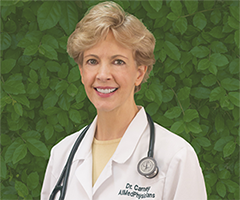DrCarney.com Blog
Consumption of soft drinks and juices and risk of liver and biliary tract cancers in a European cohort.
Consistent consumption of both sugared and artificially-sweetened beverages can trigger the development of liver cancer.
This study investigated the link between habitual drinking of soft drinks and juices and the tendency to develop cancer of the liver (hepatocellular carcinoma), bile duct, and biliary tract. Researchers followed more than 450,000 men and women who enrolled in the European Prospective Investigation into Cancer and Nutrition (EPIC) Study for 11.4 years, monitoring the soft drink consumption levels and incidence of hepatocellular, bile duct, and biliary tract cancer in the study population.
Researchers noted that frequent intake of more than 6 servings of both artificially and sugar-sweetened beverages per week increased the odds of developing hepatocellular carcinoma. Liver cancer risk was found to be 6% higher in participants who drank an extra serving of artificially-sweetened soft drinks per day. This study provides evidence that daily consumption of soft drinks may contribute to the onset of liver cancer.
Research Summary Information
-
2016
-
Stepien M, Duarte-Salles T, Fedirko V, Trichopoulou A, Lagiou P, Bamia C, Overvad K, Tjønneland A, Hansen L, Boutron-Ruault MC, Fagherazzi G, Severi G, Kühn T, Kaaks R, Aleksandrova K, Boeing H, Klinaki E, Palli D, Grioni S, Panico S, Tumino R, Naccarati A, Bueno-de-Mesquita HB, Peeters PH, Skeie G, Weiderpass E, Parr CL, Quirós JR, Buckland G, Molina-Montes E, Amiano P, Chirlaque MD, Ardanaz E, Sonestedt E, Ericson U, Wennberg M, Nilsson LM, Khaw KT, Wareham N, Bradbury KE, Ward HA, Romieu I, Jenab M.
-
Section of Nutrition and Metabolism, International Agency for Research on Cancer (IARC-WHO), Lyon, France. Rollins School of Public Health, Winship Cancer Institute, Emory University, Atlanta, GA, USA. Hellenic Health Foundation, Athens, Greece. Department of Hygiene, Epidemiology, Medical Statistics, WHO Collaborating Center for Food and Nutrition Policies, University of Athens Medical School, Athens, Greece. Department of Epidemiology, Harvard School of Public Health, Boston, MA, USA. Section for Epidemiology, Department of Public Health, Aarhus University, Aarhus, Denmark. Danish Cancer Society Research Center, Copenhagen, Denmark. INSERM, Centre for Research in Epidemiology and Population Health (CESP), U1018, Nutrition, Hormones and Women's Health Team, 94805, Villejuif, France. University Paris Sud, UMRS 1018, 94805, Villejuif, France. Institut Gustave Roussy, 94805, Villejuif, France. Cancer Epidemiology Centre, Cancer Council Victoria, Melbourne, 3053, Australia. Centre for Molecular, Environmental, Genetic, and Analytic Epidemiology, The University of Melbourne, Melbourne, 3010, Australia. Department of Cancer Epidemiology, German Cancer Research Centre, Heidelberg, Germany. Department of Epidemiology, German Institute of Human Nutrition, Potsdam-Rehbruecke, Nuthetal, Germany. Molecular and Nutritional Epidemiology Unit, Cancer Research and Prevention Institute - ISPO, Florence, Italy. Epidemiology and Prevention Unit, Fondazione IRCCS, Istituto Nazionale dei Tumori, Milan, Italy. Dipartamento di Medicina Clinicae Chirurgias, Federico II University, Naples, Italy. Cancer Registry and Histopathology Unit, "Civile M.P. Arezzo" Hospital, Ragusa, Italy. Molecular and Genetic Epidemiology Unit, Human Genetics Foundation (HuGeF), Torino, Italy. National Institute for Public Health and the Environment (RIVM), Bilthoven, The Netherlands. Department of Gastroenterology and Hepatology, University Medical Centre, Utrecht, The Netherlands. The School of Public Health, Imperial College London, London, UK. Department of Epidemiology, Julius Center for Health Sciences and Primary Care, University Medical Center Utrecht, Utrecht, The Netherlands. Department of Community Medicine, Faculty of Health Sciences, University of Tromso, The Arctic University of Norway, Tromsø, Norway. 25 Department of Medical Epidemiology and Biostatistics, Karolinska Institutet, Stockholm, Sweden. 26 Department of Research, Cancer Registry of Norway, Oslo, Norway. 27 Samfundet Folkhälsan, Helsinki, Finland. 28 Division of Epidemiology, Norwegian Institute of Public Health, Oslo, Norway. 29 Public Health Directorate, Asturias, Spain. 30 Unit of Nutrition, Environment and Cancer, Cancer Epidemiology Research Programme, Catalan Institute of Oncology (ICO-IDIBELL), Barcelona, Spain. 31 Department of Epidemiology, Murcia Regional Health Authority, Murcia, Spain. 32 Public Health Division of Gipuzkoa, Health Department of Basque Region, BioDonostia Research Institute, San Sebastian, Spain. 33 CIBER Epidemiology and Public Health CIBERESP, Madrid, Spain. 34 Navarre Public Health Institute, Pamplona, Spain. 35 Department of Clinical Sciences - Malmö, Lund University, Malmö, Sweden. 36 Diabetes and Cardiovascular Disease, Genetic Epidemiology, Department of Clinical Sciences in Malmö, Lund University, Malmö, Sweden. 37 Public Health and Clinical Medicine, Nutritional Research, and Arctic Research Center, Umeå University, Umeå, Sweden. 38 School of Clinical Medicine, Clinical Gerontology Unit, University of Cambridge, Cambridge, UK. 39 MRC Epidemiology Unit, University of Cambridge, Cambridge, UK. 40 Cancer Epidemiology Unit, Nuffield Department of Population Health, University of Oxford, Oxford, UK. 41 Department of Epidemiology and Biostatistics, School of Public Health, Imperial College, London, UK. 42 Section of Nutrition and Metabolism, International Agency for Research on Cancer (IARC-WHO), Lyon, France. jenabm@iarc.fr.
-
Yes, Free full text of study was found:
When you subscribe to the blog, we will send you an e-mail when there are new updates on the site so you wouldn't miss them.



